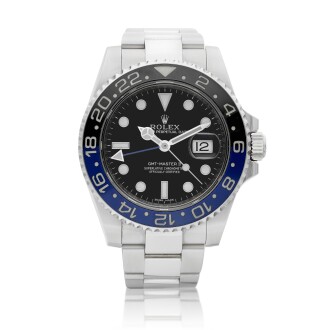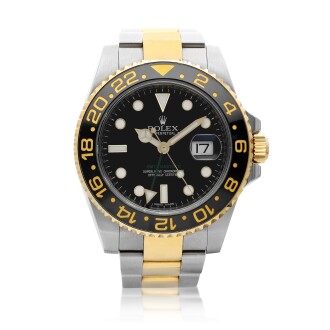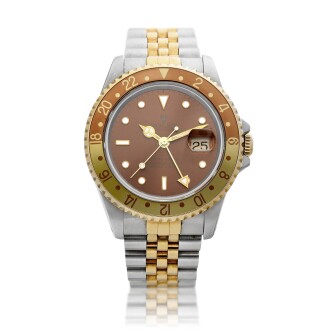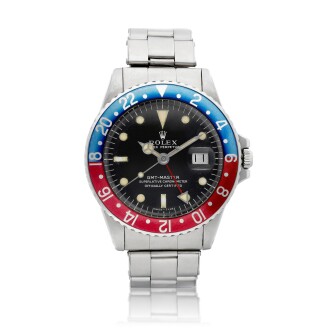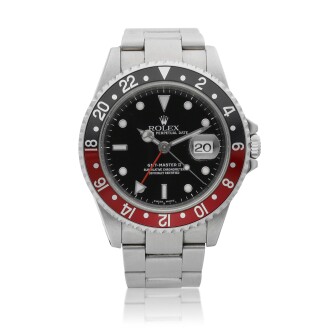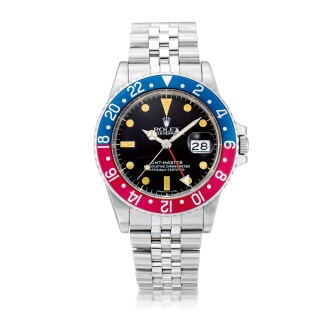
T hanks to the recent revival of Eero Saarinen’s TWA terminal at John F. Kennedy Airport, nostalgia for the golden age of jet-set travel is stronger than ever. Before TSA and sweatpants became airport fixtures, flying was an unabashedly glamorous affair: chateaubriand and martinis up in the sky! Stewardesses sporting Balenciaga and Valentino! It was this era of futuristic decadence that yielded one of history’s most iconic timepieces: the Rolex GMT-Master.
Back in the 1950s, commercial airlines had opened up a whole new world of exploration, allowing one to get from A to B with unprecedented ease. But watches hadn’t quite caught up to the continent-hopping technology. Speedily crossing through time zones required considerable juggling to tell the time while in transit. This was especially troubling for pilots, whose job relies on precision. In search of a timepiece that could better serve their fleet, Pan Am challenged Rolex to create a watch equipped to display two time zones — for both the departure city and destination — simultaneously.
How the Rolex GMT-Master Became the Ultimate Traveller’s Watch
Having made watches that endured scaling Mount Everest and swimming the English Channel, Rolex already had a reputation for durable, utilitarian watches built for adventure. When it debuted in 1955, the GMT-Master did not disappoint. In typical Rolex fashion, the watch offered an elegant solution to a practical need. The GMT-Master’s subtle stroke of genius was the addition of a fourth 24-hour hand, in addition to the standard hour, minute and second hands, to indicate the hour for a second time zone.

Buy a Rolex GMT Now
Pan Am challenged Rolex to create a watch equipped to display two time zones — for both the departure city and destination — simultaneously.
This is bolstered by the GMT-Master’s distinctive two-tone rotating bezel with 24-hour numerals — pilots could set the fourth hand to Greenwich Mean Time (the standard which all time zones are measured against) and rotate the bezel accordingly. If traveling from New York (GMT-4) to London (GMT+1), one would rotate the bezel clockwise five clicks. More than a mere design flourish, the bezel’s two colors correspond to daytime (red) or nighttime (blue) hours; this simple addition made even easier work of quickly determining the time in a foreign locale.

W hile the GMT-Master was created to serve professional pilots, its function was equally attractive to the burgeoning class of frequent flyers. Soon, it became the watch of the jet-set elite — a symbol of well-traveled worldliness. No longer reserved for Pan Am staffers, the GMT-Master was spotted on the wrists of everyone from Pablo Picasso to Hunter S. Thompson, Che Guevara and 1964 Bond girl Pussy Galore in Goldfinger. With utility and style in equal measure, the GMT-Master remains one of Rolex’s most emblematic models to this day.

Many collectors covet highly complicated timepieces, mainly as examples of technical virtuosity. Certainly tourbillons and minute repeaters are stunning feats of horological skill, but the GMT is one of the few complications that still has practical relevance in the modern era. For anyone who does business internationally or communicates with loved ones far from home, navigating time zones is a very real part of everyday life. Is the Hong Kong office still open? Is Mom awake yet? The GMT-Master answers such questions with a quick glance of one’s wrist — more easily and gracefully than clicking through the clock app on one’s phone.

T he GMT-Master’s enduring appeal has spawned numerous variations since it was first introduced. The most notable shift between the different iterations is in the GMT-Master’s signature bezel. The original’s blue and red bezel is affectionately known as the “Pepsi” among collectors; later variations include the red and black “Coke”, brown and gold “Root Beer”, and blue and black “Batman”. An original reference 6542 in yellow gold with a brown Bakelite bezel (a material that was rarely used after 1956) set the record for a GMT-Master sale at auction.
Reference 1675, introduced in 1959 and produced until 1980, is one of the most highly sought-after GMT-Master models amongst collectors. Of these models, the reference 16753 “Root Beer” or “Clint Eastwood” is particularly lust-worthy. Where Paul Newman had his Daytona, Eastwood has long championed this eye-catching style, wearing it in numerous films. With its two-tone steel and yellow gold bracelet, rich chocolate dial and tonal brown bezel, the 16753 exudes 1970s swagger.
Soon, it became the watch of the jet-set elite — a symbol of well-traveled worldliness.

In 1983, Rolex introduced the GMT-Master II equipped with an amped-up movement and independent hour and 24-hour hands that, along with the rotating bezel, allow one to calculate a third time zone. Aesthetically, the two models are near identical; the real difference is the powerful mechanics ticking away inside the GMT-Master II. Ever evolving toward greater precision, Rolex ceased production of the GMT-Master in 1999 to focus on the technologically advanced GMT-Master II. Eventually, the aluminum bezel inserts were replaced with virtually indestructible ceramic in several of the iconic color combinations. But, for the most part, this classic has retained all the trappings that made it part of the modern watch canon. Whether contemporary or vintage, the GMT-Master’s jet-set allure is still an international emblem of the high (flying) life.
For live updates on available GMTs, follow Sotheby's Watches on Instagram.



